
|
Note ye ed's email address: stevebryant99@gmail.com. |


How to be Juan Tamariz in 600 pages.
|
Return to our January 2019 issue for a look at Magi-fest 2019 and at Harapan Ong's Principia. |
February 2019 Feliz día de San Valentín! We wish you a Happy Valentine's Day in Spanish, in honor of Juan Tamariz's new book in English and of a new version of Triumph in English from Jim Krenz, who speaks fluent Spanish. Clear? Juan Tamariz attended Magi-fest 2019, but I failed to catch him in session (too old to stay up all night, too feeble to wrestle my way through the crowd). Therefore, to evoke what a Tamariz session looks like, I am running some photos from Magi-fest 2014. The smatterings of Spanish in this issue are courtesy of Google, and my apologies for any errors. Meanwhile, as we bid farewell to February, I hope you received your share of kisses on the 14th , both chocolate and otherwise. Love and sweets to all. |
|
|
JUAN TAMARIZ IN THEORY -- How does one go about conveying the scope, if not the wisdom, of Juan Tamariz's theoretical magnum opus, The Magic Rainbow? For want of a better approach, I'll go with a chapter by chapter look, all adding up to how you might make your magic approach Juan's magical ideal, The Magic Rainbow, a term and a book first promised in The Five Points of Magic: There (in The Magic Rainbow) we will study the classic effects and their symbolic value, the magic of dreams and desire, and how to increase their fascination, how to make them even more memorable; that is, how to enhance the essence of their magic. Chapter 1 ("Magic") and Chapter 2 ("How Is It Produced?"). In his Acknowledgments, Juan describes his book as "little more than a mosaic made of articles and essays I've written throughout a period of almost forty yers." Particularly in these first two chapters, one encounters essays with titles the likes of What Is Magic?, Magic and Art, Dreams of Magic, and so on. These are lyrical and evocative homages to the goddess Magic, similar in content and tone to Pageant and Prolegomenon that open Greater Magic. I thoroughly enjoyed them, but, as insightful and poetic as they are, I was looking forward to more substance in the ensuing 600 pages. Fortunately, Juan grants all wishes, and beginning in the next chapter he lays out marvelous, specific strategies for making your magic as good as it can be. 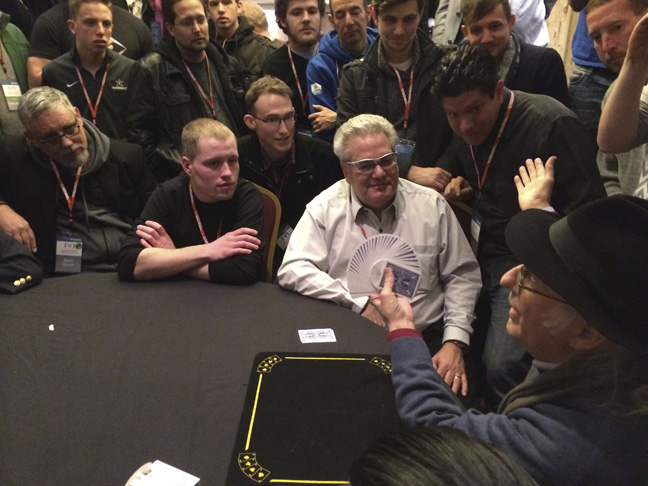 Juan in session, 2014. Chapter 3 ("The Magical Effect and Its Significance"). Juan explores what elements a good effect should have, what the classic effects are, why they are classic effects, the importance of symbolism, how to make effects more fascinating, variety in effects, and more. The essay "An Example of a Practical Application of the Theory of Symbolic Magic" lists 27 ways to improve your golf ball routine. Chapter 4 ("Magic and Memory"). Possibly the most useful chapter in the book. Juan cares about how the effect is first perceived and long remembered (the Comet Effect), with techniques for controlling the encoding, storage, and retrieval of that information. I attended a Tamariz session years ago iin which I swore every trick was done with a borrowed, shuffled deck. Chapter 4 explains how I was so bamboozled by his control of what I noticed and remembered. Chapter 5 ("Dramaturgy"). Juan studies emotions in magic, listing 165 in 40 groupings and the tricks that produced them. He graphically charts interest vs. time, favors being oneself vs. being a character (and that magic be "real time" vs. a recalled fiction), and discusses Time, Patter, and the Art of the Pause. There is a lovely story of a visit to Patagonia when Juan had to solve a problem with his perfromances. Chapter 6 ("The Secrets"). Juan asserts that there are seven veils of mystery: Love for what you do, Effort, Knowledge and wisdom, Energy, Truth, A rich inner world, and Love. Add in the parable of the Seven Little Monkeys, the most unforgettable show Juan ever saw. Or did he? Chapter 7 ("The Magic Pyramid"). I've been exposed to pyramid metaphors since my earliest days in basketball, with a sequence of coaches trying to instill us with winning ways. Juan resorts to the pyramid to depict five very important elements of good magic. The surprise was that his least important is Presentation, which he ably argues. For the record his most to least include Persona, Effect, Method, Emotions, and Presentation. Chapter 8 ("Styles in Magic"). After a couple of nice essays from the 70s (on impromptu magic and accessories), Juan tackles Magic and ... Comedy, Manipulation, and Mentalism. Comedy is the longest section (surprise! 39 pp), and, as Mac King says in a filmed promo, it's a graduate course in comedy and magic. 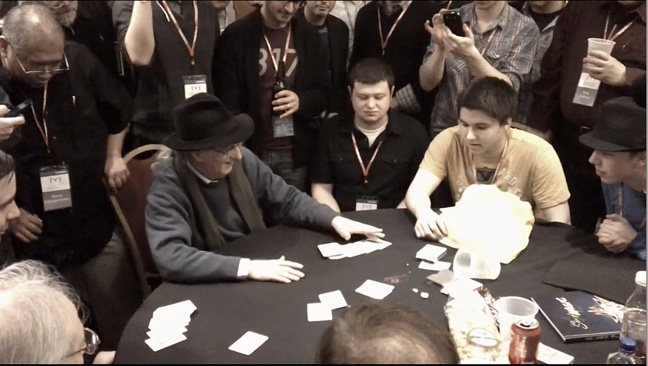 Does anyone remember whose cards are whose? 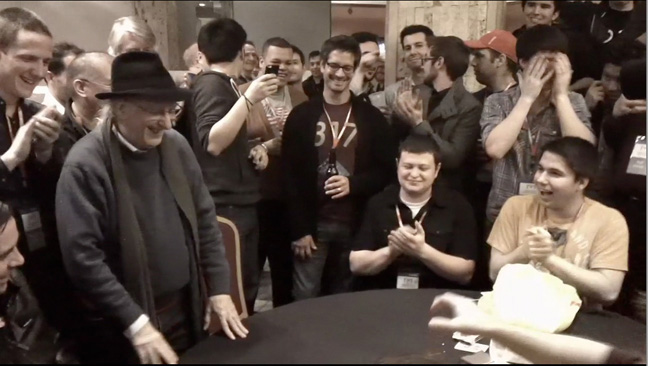 Juan accepts applause. Chapter 9 ("About the Construction of the Session"). Juan delimits performances at the levels of Effect, Trick, Routine, Act, and Session or Show. The Session is a set of routines with an intermission, divided into seven sections (odd number rule), in which Juan can choose from a secret menu of tricks and routines for each section. Having attended juan's performances on occasion, I enjoyed learning how tightly each was structured. Chapter 10 ("Creating Illusion"). An essay of eight advantages and pleasures that technique adds, and a list of 20 outs for when things go wrong (10 for card tricks that go wrong). Incredibly useful. Chapter 11 ("Confessions"). Juan reveals some purely personal choices: likes long multi-phase routines, no special props, no cards as characters, no topological card tricks, likes gimmicks made from playing cards, tricks that reveal biography, that radiate energy. Chapter 12 ("Nostalgia"). Letters, some of which he used to hand out, to spectators advising them how to enjoy a magic show. A sample nugget of advice: But in magic, there is a trick! Right. But figurative painting is also an illusion of reality. And when we look at a painting, we don't think that that blob is a certain amount of oil of a specific color. No, that blob is an eye or the fold of a cloth, or the moon, or a woman's smile. There are three Appendices, the most amazing containing a list of Wishes for mankind and the tricks that fulfill those wishes.
* * * * *
This is a book of what is commonly called theory. If you want Juan's methods, techniques, and tricks or routines, I refer you Mnemonica, Sonata, The Magic Way, The Five Points of Magic, or Verbal Magic. I might also mention Secretos de Magia Potagia, a charming 126-page soft cover in Spanish, with lovely drawings. (There are a couple of tricks in Rainbow as well, to illustrate points.) Among those who have written a book or books on theory, Juan is arguably the most successful. Accordingly it is clear that he knows whereof he speaks. My other favorites include Jeff McBride's The Show Doctor and just about anything by Eugene Bruger. 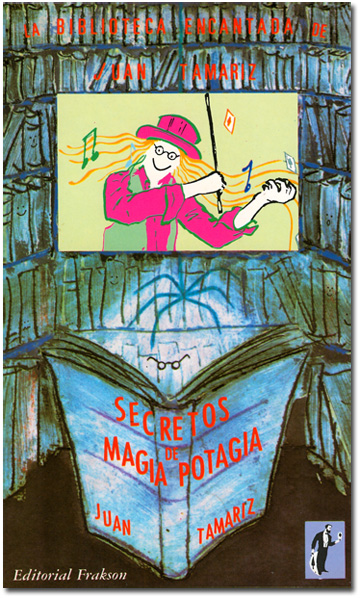 A book my son brought me from Spain. I've had the pleasure of watching Juan perform live on several occasions: in a packed session at Magi-fest, one on one dueling tricks with Chris Kenner in Las Vegas, formal close-up and stage settings, lectures, and a seminar. But Rainbow discusses material I haven't see Juan do: his Paris Act (jokers, coins, a harmonica), his Six-Card Repeat, his cod mind reading with special props, his Spirit Cabinet (floating musical instruments, ashes on paper divination, donning a jacket while tied up, Losander table, among others). I would love to see these. It's a whale of a book, alive with Juan's infectious joy. Occasionally he breaks the fourth wall even more and inserts parenthetical self-deprecating gags. Because of the precision of Juan's advice I am astounded at the skill of the translator, Rafael Benatar, and at the sharp skills of the editor, Stephen Minch. Hardbound, 612 pp, published by Hermetic Press and Penguin Magic, Inc., $149.95, available from your favorite dealer. I bought mine from H&R Magic Books. |
|
|
JIM KRENZ ON A CLASSIC -- There are wonderful sleight of hand methods for most of our classic card tricks. Nevertheless, the addition of a gimmick or two can make the original effect look oh so squeaky clean. Such is the case with Victorious Triumph from Meir Yedid Magic, Jim Krenz's addition to the Triumph methodology. With the help of some extra cards gaffed in two different ways, Jim elevates a John Bannon method to a new level of deception. Indeed, Jim's gaffs make possible cleaner effects for Triumph, Cards Across, and Ace Assembly, all taught on the accompanying one-hour DVD. 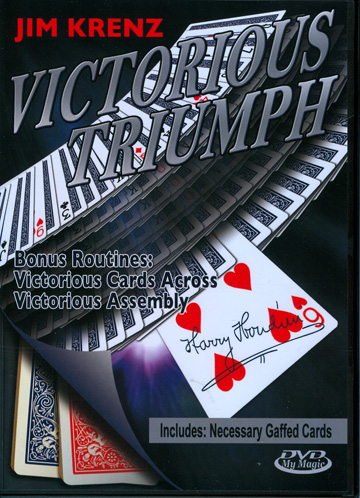 Squeaky clean effects from Jim Krenz. I didn't need a new method for Triumph -- the original Vernon method in Stars of Magic, also available from Meir, is just fine -- but a deal is a deal. Meir challenged me to watch the video of his performance and to buy the trick if I was fooled. I was (though not for the reason Meir thinks), hence I bought. This is a fine method, especially for Triumph, and you can have multiple cards selected, all signed if you so choose, with the spectators doing the shuffling that mixes the cards. Check out Meir's performance on his web site. $30 for all, the DVD nd all the gaffed cards. |
|
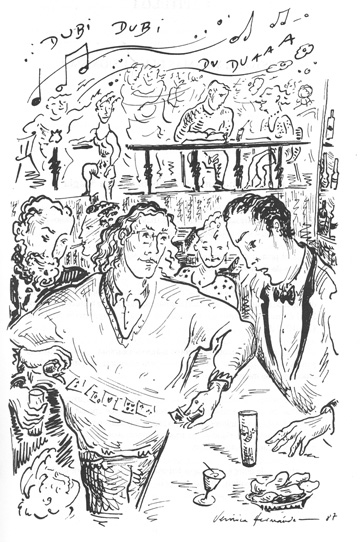 From Secretos de Magia Potagia.
Farewell to my local Barnes and Noble. Come back soon!
Follow us on Twitter. Little Egypt Magic is the erratically updated web site of Steve Bryant, spawned (the site, not Steve) by a former internet magazine known as The Little Egypt Gazette/for magicians only. Steve Bryant is an obscure magician and writer who generates this site from an iMac in Bloomington, Indiana. He used to frequently journey to and perform magic in Little Egypt, the local name for extreme southern Illinois, where the towns bear such names as Cairo, Thebes, and Karnak. Past issues of this web site: Index to Past Issues Notice: Any limited use of copyrighted images or quoted text is considered fair use, usually to review whatever product or event that is under discussion. If you object to use of any material, please get in touch and it will be cheerfully removed. |
A JSB Creations product
Copyright© 2019 by Steve Bryant